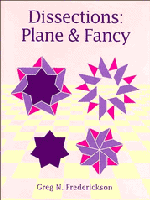Book contents
- Frontmatter
- Contents
- Preface
- 1 “Dat Pussle”
- 2 Our Geometric Universe
- 3 Fearful Symmetry
- 4 It's Hip to Be a Square
- 5 Triangles and Friends
- 6 All Polygons Created Equal
- 7 First Steps
- 8 Step Right Up!
- 9 Watch Your Step!
- 10 Just Tessellating
- 11 Plain Out-Stripped
- 12 Strips Teased
- 13 Tessellations Completed
- 14 Maltese Crosses
- 15 Curves Ahead
- 16 Stardom
- 17 Farewell, My Lindgren
- 18 The New Breed
- 19 When Polygons Aren't Regular
- 20 On to Solids
- 21 Cubes Rationalized
- 22 Prisms Reformed
- 23 Cheated, Bamboozled, and Hornswoggled
- 24 Solutions to All Our Problems
- Afterword
- Bibliography
- Index of Dissections
- General Index
5 - Triangles and Friends
Published online by Cambridge University Press: 05 August 2012
- Frontmatter
- Contents
- Preface
- 1 “Dat Pussle”
- 2 Our Geometric Universe
- 3 Fearful Symmetry
- 4 It's Hip to Be a Square
- 5 Triangles and Friends
- 6 All Polygons Created Equal
- 7 First Steps
- 8 Step Right Up!
- 9 Watch Your Step!
- 10 Just Tessellating
- 11 Plain Out-Stripped
- 12 Strips Teased
- 13 Tessellations Completed
- 14 Maltese Crosses
- 15 Curves Ahead
- 16 Stardom
- 17 Farewell, My Lindgren
- 18 The New Breed
- 19 When Polygons Aren't Regular
- 20 On to Solids
- 21 Cubes Rationalized
- 22 Prisms Reformed
- 23 Cheated, Bamboozled, and Hornswoggled
- 24 Solutions to All Our Problems
- Afterword
- Bibliography
- Index of Dissections
- General Index
Summary
With the bustle of Massachusetts Avenue behind him, Harry C. Bradley strode briskly along the gravel path laid parallel to the bank of the Charles River basin. He then pivoted 90° to face the Grand Court of the New Technology. The interconnecting stone buildings massed to form pavilions on either side as he approached the main portico of this new temple of progress. He was a professor at the premier technology school of a nation newly confirmed on the world stage. The dome in front of him capped the colonnaded center of these commandingly geometric buildings. In the few years since the move from the old “Boston Tech” on Boylston Street, he had responded to this realization of a dream with a constructive geometry of his own: transforming the hexagram into a square and imposing that cornerstone of Greek mathematics, the Pythagorean theorem, on that most fundamental of shapes, the equilateral triangle.
The year was 1922, and the place was the gleaming new campus of the Massachusetts Institute of Technology (MIT) in Cambridge, Massachusetts. The quiet professor of descriptive geometry felt justly proud of the result that he had sent off as a problem for the readers of the American Mathematical Monthly (AMM). He had turned around centuries of geometric practice by illustrating the Pythagorean theorem with equilateral triangles instead of squares. His dissection of triangles of side lengths x, y, and z graphically illustrated the relation x2 + y2 = z2.
- Type
- Chapter
- Information
- DissectionsPlane and Fancy, pp. 40 - 50Publisher: Cambridge University PressPrint publication year: 1997



